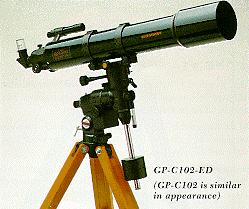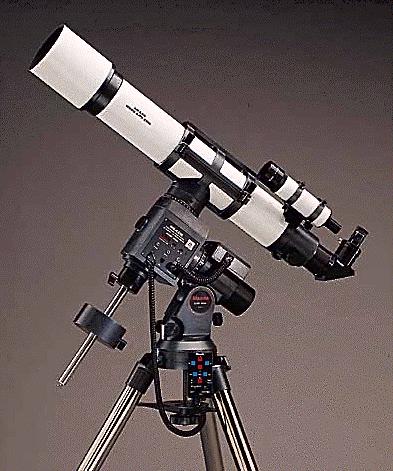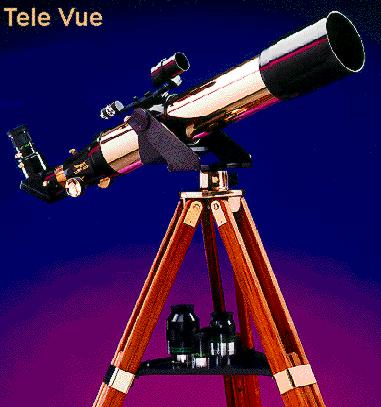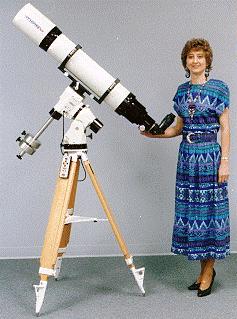Comparing Refractors
Update: In the years since this article was first written, many of the telescopes reviewed here have been replaced by newer models. However, if you happen to be in the market for a used telescope, then the info in this article might be helpful.
Jack Kramer
If you like the quality of images offered by a refractor, what will it take to own one? An article in this newsletter touting the advantages of small-to-medium-sized refractors noted that they're quite a bit more costly than reflectors with comparable light-gathering ability. The specifics? There are several good brands of refractors on the market, and within the same size ranges, the prices are generally comparable. If you're considering this type of telescope, for about $500 you can get a good 3-inch (e.g.: Celestron Premium 80). Top-of-the-line department store 60mm (2.4-inch) refractors run about half that much. Unfortunately, even the best department store versions come with many third-rate components that limit their value. Some people have done serious observing with these 60mm scopes, but only after making necessary modifications. The price for larger refractors ratchets up pretty quickly. Although a 4-inch scope is nowadays considered small, in the world of refractors, a 4-inch is generally regarded as the start of the "medium" size range. Although it's open to debate, knowledgeable people have said that a 3-inch refractor is the minimum size that allows good views of anything smaller and fainter than the moon. It is also generally stated that the resolution needed for serious planetary study requires an aperture of at least 5-inches.

A 4-inch Celestron GP-C102 costs about $1400, and includes a sturdy equatorial mount. Add another $400 if you want a clock drive. The GP-C102 is an achromat, which means that most, but not all, of the chromatic aberration is eliminated. Today, many of the larger refractors are equipped with apochromatic ("APO") lenses, which eliminate virtually all the residual colored glow caused by chromatic aberration. The Celestron model GP-C102ED is an apochromat, and it costs about $1000 more than the achromatic version; the rest of the components are virtually identical. Celestron doesn't actually manufacture these scopes themselves; they're made by Vixen -- a Japanese firm. Orion Telescopes recently began offering their version of this same scope. The Orion instrument is a different color and uses an aluminum tripod instead of a wooden one, but otherwise it seems to be identical. And it costs about $100 less than the Celestron version. The Orion catalog notes that the accessories for their version also fit the GP-C102.
One cautionary note applicable to this and other refractors is to be sure to re-balance the telescope when you add any equipment, such as a camera or heavy solar filter. The long tube length of a refractor accentuates the effect of a weight added to either end. Failure to take this into account can cause slippage of the gears and/or premature wear to the drive motor. Fortunately, these scopes are easily balanced by loosening the tube rings and sliding them back and forth in the saddle.

The Meade apochromatic refractors include a sturdy German equatorial mounting at a very competitive price, starting around $2500 for a 4-inch. Of course, this is still a lot of money; refractors require a considerable financial commitment. Meade has kept its prices down (relatively speaking!) through the efficiencies of mass production. But this comes with its own cost -- they have a reputation for quality problems, especially with their clock drives. A suggestion from present Meade owners is to purchase the telescope from a local vendor so that it's easier to take it back for repair or replacement during the warranty period. From what we've heard, the quality of their apochromatic refractor optics is good. In general, it seems as though after you get any bugs worked out, you'll be pleased with a Meade product.
Meade has a less expensive line of refractors (90mm models 390/395, and the recently-introduced 500 series of 4-inch scopes which includes an APO version.) All are made in Taiwan. The 90mm model is particularly attractive, providing fairly decent light gathering at a reasonable price. I had purchased one of these several years ago but found that it had a case of astigmatism (stars all had little "tails"). I promptly returned it to the supplier, who informed me that mine was not the first instance of a problem with these optics. I swapped it for a Celestron 80mm refractor. Since the quality of these scopes is not consistent, they should be very carefully checked in actual use and immediately returned to the supplier if unsatisfactory. As with other Meade products, if everything appears okay, then this should prove to be a fine scope for visual observing.
The Tele Vue Genesis is a 4-inch apochromatic refractor that goes for around $2700, but only comes with an altazimuth mounting, albeit a very smooth and stable mounting. It's sort of a niche product: of all the 4-inch refractors, it's the shortest and easiest to transport. If you want a very good refractor that's especially easy to handle, this is it! But you will need a different mounting if you want to use it for astrophotography.

Astro Physics brand scopes are widely regarded as the epitome of refractors -- the kind that you'd be proud to pass down to your descendents. Of course, the prices start at over $4000, then head for the stratosphere! A rule of thumb is that basic Astro Physics scopes cost about $1200 per inch. Moreover, delivery often takes a year or more due to the small batch production runs and time-consuming workmanship involved in both the optics and mechanical parts.

Astro Physics 5-inch APO
These are truly high-quality telescopes, yet in side-by-side comparisons, less-expensive brands have sometimes been reported to equal the performance of the Astro Physics scopes. Several years ago, Astronomy magazine tested the various apochromatic 4-inch refractors, and the Celestron model was judged superior overall.
Meade and Astro Physics both produce APO refractors in sizes ranging from 4 through 7-inches. The larger refractors are not very portable, although they usually disassemble quite easily. If you've ever hefted one of the Meade or Astro Physics 5-inch refractors on its mounting, you know what I mean. They'd be awkward to move around without taking them apart. With the exception of the Genesis, refractors of 4-inches or larger all come with German-style equatorial mounts, which contribute considerably to the overall weight. My Celestron 4-inch is just easy enough to pick up and move from place to place when a tree or house interferes with the view of an object. Maybe I'm getting lazy in my old age, but that's probably my limit of true portability.
With regard to image quality, you would have to decide for yourself whether the cost of an apochromat (APO) is worthwhile. Observing the bright planets with the less expensive Celestron GP-C102 is the only situation under which the extraneous glow of chromatic aberration is obvious. But since I frequently use a colored filter in such cases, the effect becomes negligible. An APO probably would provide better all-around views than the achromat, but for me the extra $1000 was prohibitive.
Most Meade APO optics and all Astro Physics lenses are manufactured in this country. Other firms get most of their lenses overseas. I have heard from various sources that the best foreign-made optics come from either Japan or Germany. There are several other manufacturers of achromatic and apochromatic refractors in addition to those mentioned here; generally, their features and prices are comparable.
Besides providing crisp images, refractors are low-maintenance instruments that with reasonable care may never require re-collimating or re-coating of the lenses. Yes, they are expensive. But viewed as a lifetime investment, a good refractor may well be worth the outlay.





